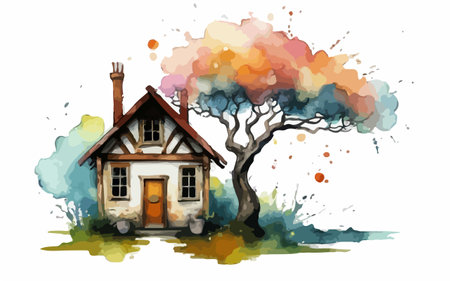Understanding Color Psychology and Its Impact on Productivity
When it comes to setting up a home office, most people focus on furniture, lighting, or tech gear. But one of the most overlooked elements is color. The colors you choose for your workspace can significantly affect how you feel and perform throughout the day. This is where color psychology comes in—a study of how colors influence human behavior, emotions, and productivity.
How Colors Affect Mood and Focus
Each color has its own psychological effect. Some colors can energize you, while others may help you concentrate or even relax. Understanding how these shades work can help you create an environment that supports your work goals.
Common Color Effects in a Home Office
| Color | Psychological Effect | Best For |
|---|---|---|
| Blue | Calming, promotes focus and mental clarity | Analytical tasks, writing, programming |
| Green | Balancing, reduces eye strain and stress | Long work hours, creative thinking |
| Yellow | Energizing, stimulates creativity and optimism | Brainstorming sessions, design work |
| Red | Stimulating, increases energy and urgency | Short bursts of physical tasks or high-energy meetings |
| White or Light Gray | Clean, minimalist feel but can feel sterile if overused | Neutral backdrop for modern setups or paired with accent colors |
| Purple or Lavender | Sophisticated, encourages imagination and calmness | Creative industries or wellness-focused workspaces |
Selecting the Right Palette for Your Needs
The right palette depends on what kind of work you do and how you want to feel in your space. If youre managing detailed spreadsheets all day, calming blues might keep you centered. If youre in a creative field like marketing or design, a splash of yellow could spark fresh ideas.
A Balanced Approach Works Best
You dont need to paint every wall a bold color. Often, using one main tone with supporting accent colors creates both harmony and visual interest. Think about adding colored artwork, rugs, or desk accessories instead of committing to a full wall makeover.
Quick Tips for Color Success in Your Home Office:
- Test first: Paint small sections before committing to a full wall.
- Consider lighting: Natural light changes how colors look throughout the day.
- Create contrast: Use different shades to separate work zones from relaxation areas.
- Add texture: Combine color with wood, metal, or fabric for depth.
- Stay true to your style: Choose colors that make you feel good—not just ones that are trendy.
The goal is to create a space that not only looks good but also helps you stay focused and motivated. By understanding how colors affect your mind and mood, youll be better equipped to design a home office that truly works for you.
2. Warm vs. Cool Tones: Finding the Right Balance
When designing your home office, understanding the difference between warm and cool tones can help you create a space that feels both inviting and productive. Each color temperature brings its own energy to a room, and finding the right mix is key to staying focused while also feeling comfortable throughout the day.
What Are Warm and Cool Tones?
Colors are generally divided into two main categories based on their undertones:
| Warm Tones | Cool Tones |
|---|---|
| Include shades like red, orange, yellow, and earthy browns | Include shades like blue, green, purple, and soft grays |
| Create a cozy, energizing atmosphere | Promote calmness and mental clarity |
| Best for spaces where warmth and motivation are needed | Ideal for areas requiring focus and relaxation |
Choosing Based on Your Work Style
If your work involves creativity or collaboration, warm tones like terracotta or golden beige can help spark ideas and keep energy levels up. On the other hand, if your job requires deep concentration or detailed tasks—such as writing, coding, or financial analysis—cool tones like soft blue or sage green might be more appropriate.
Tip:
You dont have to stick to just one side of the color wheel. A well-balanced palette often includes both warm and cool elements to support different moods throughout your workday.
How to Find Balance in Your Color Scheme
A good rule of thumb is to choose a dominant tone based on your work needs and personality, then use accents from the opposite temperature to add contrast and visual interest. For example, if your walls are painted in a cool gray-blue, consider adding a warm wood desk or rust-colored throw pillow for warmth.
Example Home Office Palette Ideas:
| Main Tone | Accent Tone | Description |
|---|---|---|
| Cool (Light Blue Walls) | Warm (Copper Lamp & Oak Desk) | A calming base with energizing touches of warmth |
| Warm (Soft Terracotta Walls) | Cool (Pale Gray Rug & White Bookshelves) | A cozy backdrop balanced by modern cool accents |
Finding the right balance between warm and cool tones helps you shape a workspace that not only looks good but feels just right for your daily routine. The goal is harmony—a space that supports productivity without sacrificing comfort.

3. Best Colors for Boosting Focus and Creativity
Choosing the right colors for your home office can make a big difference in how well you concentrate and how creative you feel throughout the day. Studies in color psychology show that certain hues can stimulate the brain, while others help keep distractions at bay. Heres a closer look at which colors work best when youre aiming to stay productive and inspired.
Colors That Enhance Focus
If your work requires attention to detail, staying organized, or handling complex tasks, youll benefit from calming and grounding shades. These colors help reduce mental clutter and support sustained concentration.
| Color | Effect on Focus | Best Use |
|---|---|---|
| Blue | Promotes calmness and mental clarity | Ideal for walls or large areas to create a steady, focused atmosphere |
| Green | Reduces eye strain and creates balance | Great for long work sessions or when working with screens often |
| Gray (Cool tones) | Keeps distractions minimal while providing a neutral backdrop | Works well in minimalist offices or paired with brighter accent colors |
Colors That Spark Creativity
If your work involves brainstorming, writing, design, or other creative tasks, youll want colors that energize and inspire you without becoming overwhelming.
| Color | Effect on Creativity | Best Use |
|---|---|---|
| Yellow | Energizes and stimulates innovative thinking | Perfect for accent walls, artwork, or decorative items |
| Orange | Boosts enthusiasm and motivation | Use sparingly in small doses to avoid overstimulation |
| Purple (Light shades) | Encourages imagination and luxury vibes | Good for creative corners or mixed with neutrals to maintain balance |
Mixing for Balance: Dual Purpose Spaces
If your home office needs to support both focus and creativity, consider blending these color families. For example, try soft green walls with yellow accents, or a blue-gray base with touches of orange. This allows your space to feel both grounded and dynamic.
Pro Tip:
Avoid overly saturated colors on large surfaces—they can quickly become distracting. Stick to muted tones for main areas and bring in bolder colors through accessories like pillows, artwork, or storage bins.
The right palette doesnt just make your office look good—it can also change how you think and feel while working. By understanding how different colors affect your mind, you can design a workspace that truly supports your goals.
4. Incorporating Accent Colors for a Personalized Touch
Once youve chosen your main color palette for your home office, it’s time to add some personality with accent colors. Accent colors can make your workspace feel more inviting and tailored to you, without overpowering the room or distracting from productivity. The key is to use them thoughtfully and sparingly.
Why Accent Colors Matter
Accent colors help break up monotony and bring balance to a space. They can highlight certain areas, showcase your style, or even inspire creativity. For example, a pop of yellow can boost energy, while touches of blue might help you stay calm and focused.
Tips for Using Accent Colors
1. Choose One or Two Accent Colors
Stick to one or two accent shades that complement your primary palette. This keeps the space cohesive and avoids visual clutter.
2. Use an Accent Wall Strategically
An accent wall can create a focal point in your office. Pick a wall thats behind or across from your desk, and paint it in your chosen accent color to draw attention without being too distracting.
3. Add Color Through Decor and Accessories
If painting isnt an option, use decor like throw pillows, rugs, curtains, or wall art to introduce accent colors. These elements are easy to swap out if your tastes change over time.
4. Keep It Balanced
A good rule of thumb is the 60-30-10 rule: 60% of your space should be your main color, 30% secondary, and 10% accent color. This helps maintain harmony while still letting your personality shine through.
Accent Color Ideas Based on Mood
| Mood You Want | Suggested Accent Colors | Where to Use Them |
|---|---|---|
| Energized & Motivated | Yellow, Orange | Pillows, Desk Accessories |
| Calm & Focused | Navy Blue, Soft Green | Curtains, Artwork |
| Creative & Inspired | Purple, Teal | Lampshade, Rug |
| Sophisticated & Professional | Burgundy, Charcoal Gray | Shelving Units, Office Chair |
A Few Final Tips on Placement
- Avoid placing bright accent colors directly in your line of sight from your desk—they might become distracting over time.
- If youre working with a small space, stick with lighter accents to keep the room feeling open.
- Add greenery as a natural accent—it complements nearly every palette and improves air quality too!
Selecting the right accent colors is all about adding layers to your workspace that reflect who you are while supporting how you work best.
5. Practical Tips for Choosing and Applying Paint Colors
Now that you understand how colors can affect mood and productivity, it’s time to apply that knowledge to your home office. Picking the right paint color isn’t just about finding a shade you like—it’s also about how it looks in your space, how it feels throughout the day, and how it interacts with your furnishings and lighting. Here are some practical tips to help you get it just right.
Test Before You Commit
Colors can look dramatically different depending on lighting, time of day, and even wall texture. Before painting the entire room:
- Use paint swatches: Apply sample patches on different walls to see how they look in natural daylight and under artificial lighting.
- Observe over a few days: Notice how the color changes from morning to evening.
- Compare with furniture: Make sure the color complements your desk, chair, shelves, and décor.
Select the Right Finish
The finish of your paint affects both appearance and maintenance. Heres a quick guide to help you choose:
| Finish Type | Best For | Pros | Cons |
|---|---|---|---|
| Matte/Flat | Low-traffic areas or ceilings | Hides imperfections well | Difficult to clean |
| Eggshell | Home offices, living rooms | Slight sheen, easy to clean | May show minor wall flaws |
| Satin | High-use spaces like home offices or hallways | Durable and smooth finish | Might highlight imperfections |
| Semi-gloss | Trim, doors, and sometimes accent walls | Highly durable and easy to clean | Reflective; shows wall defects more easily |
Avoid Common Color Mistakes
A great color can fall flat if its not used correctly. Avoid these common pitfalls:
- Ignoring undertones: A beige might have pink, yellow, or gray undertones—make sure they match your space.
- Poor lighting consideration: Natural light enhances cooler tones; artificial light often warms them up. Plan accordingly.
- Overdoing bold colors: If youre drawn to vibrant hues like red or orange, consider using them as accents rather than full walls.
- Skipping primer: Especially when changing from dark to light colors, priming ensures true color payoff.
Your Home Office Checklist Before Painting:
- Select 2–3 potential colors based on desired mood (e.g., blue for focus, green for calm).
- Buy sample sizes and test on multiple walls.
- Evaluate under both natural and artificial lighting.
- Select the appropriate paint finish for durability and look.
- Avoid clashing undertones with existing furniture or décor.
The right paint color can transform your home office into a space that feels productive, inspiring, and comfortable. With these simple steps, you’ll be well on your way to creating a work environment that works for you.

